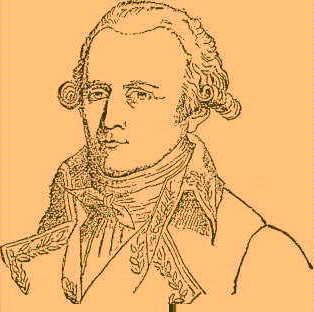Jean-Baptiste de Lamarck
.
 "A
teoria da progressão dos animais de Lamarck"
"A
teoria da progressão dos animais de Lamarck"
["Lamarck´s theory of the
progression of animals"] Abstract
Lilian Al-Chueyr
Pereira Martins
Campinas: Universidade Estadual de Campinas, 1993.
(Dissertação de Mestrado)
xxx + 403 páginas
Resumo: Como é bem conhecido, a teoria da progressão
dos animais de Lamarck teve um baixo impacto e uma mínima aceitação
em sua época. Além disso, pouco se conhece a respeito dessa
teoria atualmente, bem como da obra de Lamarck. O objetivo desta dissertação
é estudar a teoria da progressão dos animais em Lamarck,
sem lidar com o limite superior da escala (o homem), dentro de seu contexto
histórico, descrevendo-a e verificando sua fundamentação.
Procura-se averiguar se o tratamento que ela recebeu na época foi
devido a uma proposta científica fraca (má fundamentação)
ou se, do ponto de vista científico, ela deveria ter merecido maior
respeito e consideração.
Esta dissertação contém uma
introdução e dez capítulos. A introdução
procura esclarecer alguns pontos importantes como a abordagem utilizada,
a delimitação do objeto de estudo e o método da presente
pesquisa. Os capítulos 1 a 5 são descritivos, estudando o
conteúdo da teoria de Lamarck, comparativamente, em suas obras originais.
O capítulo 1 trata da vida e obra de Lamarck. Os capítulos
2 a 5 descrevem alguns aspectos da teoria de Lamarck: geração
espontânea, escala animal, variação das espécies
e as quatro leis de que regem a progressão dos animais. Como existem
várias versões da teoria de Lamarck, encontradas em diferentes
obras, essa descrição conterá uma comparação
minuciosa em relação à seqüência, coerência
e terminologia, verificando que não ocorreram mudanças significativas
na teoria de Lamarck com o passar do tempo.
Os capítulos 6 e 7 estudam como Lamarck fundamenta
os pontos descritos nos capítulos 2 a 5, apontando as eventuais
lacunas metodológicas e enfatizando os aspectos positivos; analisam
o discurso metodológico e a concepção epistemológica
de Lamarck e investigam se sua prática é coerente com essa
visão. Para contextualizar a discussão, os capítulos
8 e 9 apresentam antigas críticas a Lamarck e algumas alternativas
de teorias desenvolvidas na época. O capítulo 10 apresenta
uma conclusão a respeito de tudo o que foi visto antes. A proposta
de Lamarck não é uma proposta científica fraca. Ela
mereceria um maior respeito e consideração por parte de seus
contemporâneos, pois possui muitos aspectos positivos e contribuições
valiosas. Há porém lacunas metodológicas e foram essas
que abriram espaço para críticas de adversários de
Lamarck, contribuindo para seu baixo impacto e mínima aceitação.
Há porém, outros fatores que contribuíram para isso
cujo estudo foge às limitações desse trabalho.
Grupo
de História, Teoria e Ensino de Ciências - UNICAMP
"A
teoria da progressão dos animais de Lamarck"
["Lamarck´s theory of
the progression of animals"]
Lilian Al-Chueyr Pereira Martins
Campinas: Universidade Estadual de Campinas, 1993.
(MSc Dissertation)
xxx + 403 pages
Abstract: It is well known that Lamarck's theory of the progression
of animals had a low impact and minimal acceptance in his own time. Little
is know nowadays about this theory and about Lamarck's work. The aim of
this dissertation is to study Lamarck's theory of the progression of animals,
leaving aside the upper bound of its scale (man). The theory is described
and studied in its historical context. Its foundations are discussed. This
work tries to elucidate whether the negative treatment received by this
theory in its time was due to a weak scientific proposal (weak foundations)
or whether the theory deserved a greater respect and consideration, from
the scientific point of view.
This dissertation contains an introduction and ten
chapters. The introduction aims at elucidating some relevant points such
as the historiographic approach of this work, the scope of the inquiry
and the research method of the dissertation. Chapters 1 to 5 are descriptive.
They study the scientific content of Lamarck's theory, from a comparison
between his several original works. Chapter 1 provides an overview of Lamarck's
life and work. Chapters 2 to 5 describe the main points of Lamarck's theory:
life and spontaneous generation; the scale of animals; the variation of
species; and the four laws of animal progression. Since there are several
different versions of Lamarck's theory in his works, this description contains
a detailed comparison between those versions as to their concepts, sequence,
terminology and mutual coherence. It is shown that there were no significative
changes of Lamarck's theory over the studied time span.
Chapters 6 and 7 study the foundations presented
by Lamarck for each of the points described in chapters 2 to 5. The dissertation
points out existing methodological gaps and emphasises positive features.
It analyses Lamarck's methodological discourse and his epistemological
views, checking the coherence between those views and his scientific practice.
To contextualise this discussion, chapters 8 and 9 present some old criticisms
against Lamarck and several alternative theories of his time. Chapter 10
presents a general conclusion. It is shown that Lamarck's proposal was
not scientifically weak. It deserved a higher respect and consideration
from his contemporaries, since it exhibited several positive aspects and
valuable contributions. There were, however, some methodological gaps in
his work and they made room for several criticisms against Lamarck's theory.
This contributed to its low impact and minimal acceptance. There were,
however, other causes that contributed to this result; but they fall outside
the scope of this dissertation.
Group of History and Theory
of Science – UNICAMP, Brazil
 "A
teoria da progressão dos animais de Lamarck"
"A
teoria da progressão dos animais de Lamarck"